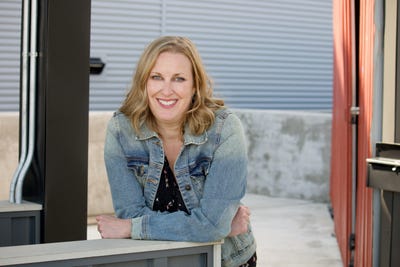7 ways to be smarter about school lunch on social media
School food advocate and social media maven Dayle Hayes shares her expertise on how to react to negativity from students, parents and trolls, how to turn around a bad situation and how to make social media a positive aspect of your program.
Dayle Hayes, MS, RD, started School Meals That Rock a few years ago after seeing school lunch programs getting bullied online, on TV and IRL (in real life). Hayes had noticed negative posts from peevish parents and kids—and even an oddly determined chiropractor in Arizona—but the last straw came in the form of two incidents: celebrity chef Jamie Oliver breezing into a rural school district and acting as if they’d never heard of fresh fruits or vegetables before, and an anonymous blog that posted an awful school lunch photo every day.
“When Jamie Oliver went to West Virginia, he was like, ‘These people are doing a terrible job.’ But I happened to know that district had been doing culinary training and the things he was saying and the reasons he was picking on them were totally unfair,” Hayes recalls, adding that seeing the blog with daily terrible school lunch photos sparked an idea.
“My reaction was, ‘That’s not all school meals.’ I was pretty sure I could come up with at least one school meal a day that rocked,” Hayes says. “In the beginning it was hard. I had to work at finding pictures. But now it’s a totally different situation.”
It’s true. Hayes’ School Meals That Rock Facebook page and website have become a gathering place for school lunch professionals to feel support, show off the good stuff they’re doing and, sometimes, fight back.

TALKING BACK: “A lot of times people say to me, ‘There’s no fresh food in school lunch.’ I say, ‘I can prove you wrong,’” says Dayle Hayes of School Meals That Rock. Photo: Carrollton City Schools
In a recent post, Hayes draws a line in the sand: “To all the mommy bloggers, food celebrities, academic researchers, restaurant chains and media channels who want to blame School Lunch for the ills of the US food system (while promoting their own products, endorsements and programs), it’s time to STOP.”
Hayes goes on to bust some myths about school lunch (people, can we please get over the “ketchup is a vegetable” thing already?) and encourages finding out the truth—or, (gasp!) actually offering to help—before spouting off online.
She took some time to speak with us about her best practices for making social media a positive aspect of your school lunch program—and what to do when negativity strikes.
1. Don’t stick your head in the sand.
“A lot of school districts are either blindsided, or it’s the thing that holds them back,” Hayes says. “I hear all the time from people, ‘I don’t want to be on social media because people may say bad things about my program.’ I tell them, ‘People are saying bad things anyway.’”
The advantages to having a social media presence means taking your rightful chance to be part of the conversation. In addition, it’s a way to get your positive news out and establish a presence that people can see for themselves.
Hayes points to one example, a photo of a very unappealing piece of fish on a school lunch tray that looked uncooked and was accompanied by some sad-looking corn that went viral. That school district had no social media presence, and no real way to counter that photo.
“My first thought was that it was just a bad picture; the food wasn’t so bad,” Hayes says. “But that district had no way to say, ‘Sorry about that, but look at the gorgeous lunches we served in the 40 days leading up to this.’”
2. You don’t have to spend all day on social media.
“The people I know who are the most effective spend about 10 to 15 minutes a day on social media,” Hayes says.
3. Go ahead and hand off the day-to-day social media responsibility to a millennial or Gen Xer on your team.
“A lot of directors I know are in an older demographic and don’t necessarily have the social media-savvy skills, but their staff do.” Hayes says one way to develop leadership is to put one of your staffers in charge of social media and let them run with it: taking photos, posting about events, etc.
How to handle a negative social media post
4. Take a deep breath when criticism comes.
What to do when you’re the target of negative posts or comments? Or heaven forbid a nationwide viral embarrassment?
“First, take a deep breath,” Hayes says. “Don’t post when you’re angry or upset. And don’t just delete it. The immediate tendency is, ‘Someone said something bad, I better get rid of it.’ The problem is, if you just delete it, you’re not having that conversation.”
5. Once you’re taken a deep breath, ask yourself if it’s valid criticism.
“When a kid posts a bad pic, was it really a bad lunch? Was there something gross in it? Or was someone trying to make it look bad?”
Hayes has observed that kids will often post gross photos after they’ve made a mess out of their own tray. That’s not something you have to respond to.
But if it is valid—say, for example, a photo of a moldy roll—you should apologize directly and even invite the person (if it’s a parent) to come to the school. Let them know you messed up (in this case, possibly a slip-up in inventory control) and how you’re handling it.
6. Determine the source and their reach.
“Check and see what the reach of that person is,” Hayes says. “Someone sent me a photo they were so worried about from a student, but that student just had 14 followers.”
That doesn’t mean to not respond, just to not freak out. And Hayes cautions to keep things in perspective by keeping tabs on the folks who are speaking out.
“Is this a cranky mom who complains about everything? If someone complains, follow them,” she says. “What you see in parents and adults is that they are probably complaining about a lot of things, from the bus driver to the curriculum.”
*An important caveat: You’re never obligated to respond to a troll. A troll is someone who lives to make the internet uglier and create turmoil, Hayes says. Feel free to block and/or report someone who is abusive.
“If someone is a troll, and by that I mean they are awful, continually talk about how awful things are and aren’t really interested in a solution, I just block that person,” she says. “You have that power on any social media channel to ban a person. I don’t take it lightly, though; I take the idea of conversation very seriously.”
7. Bring that naysayer into the fold.
It’s harder to talk smack face-to-face—so many won’t ever take you up on this, but an offer to critics to come tour your operation can sometimes lead to new friends and allies.
“Ask them to do more than just sit back and comment,” Hayes says. “For example, at an Arizona school district there was a local chiropractor who kept posting that they were serving toxic food. So they invited him in and took him on a tour and provided transparency. All he was looking for was transparency, it turned out.”
When it comes to students, Hayes has seen school districts have a lot of success by pre-emptively offering taste tests of new items. Students feel more like they have a voice, and are less likely to vent on social media about school lunch.
“Turn your critics into partners whenever you can,” Hayes says.
About the Author
You May Also Like






